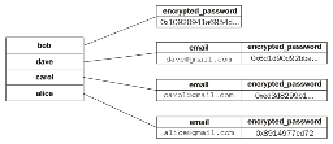Database Reference
In-Depth Information
Developing a mental model for Cassandra
Any time you learn a new tool, you will naturally begin to develop a mental model for how
that tool works. So far, our model for how Cassandra tables works is fairly simple; we will
expand upon it throughout the topic.
For now, we can think of a Cassandra table as a collection of keys, each of which points to
a row. Each row contains data in some subset of its columns.
We also know that, at least in the
users
table, rows are stored non-contiguously; access-
ing each row requires Cassandra to seek a different place in storage. So we may imagine
the current state of our
users
table to look something like this:
Essentially, we can think of our Cassandra table as a key-value store, where each value
consists of one or more predefined columns containing data of a predefined type.

